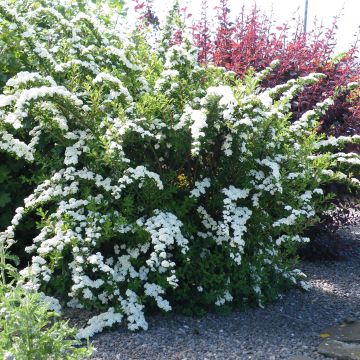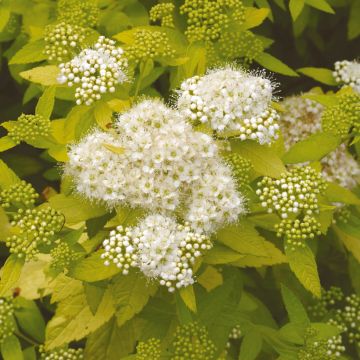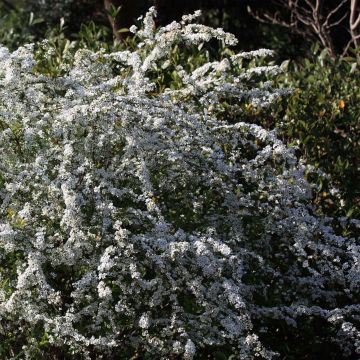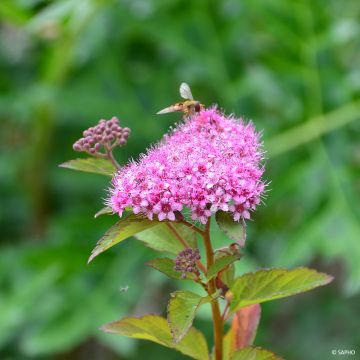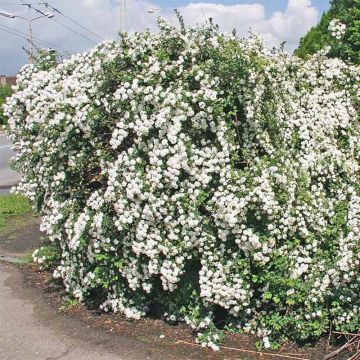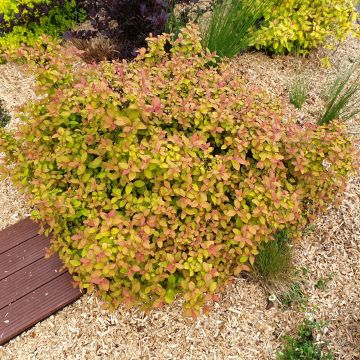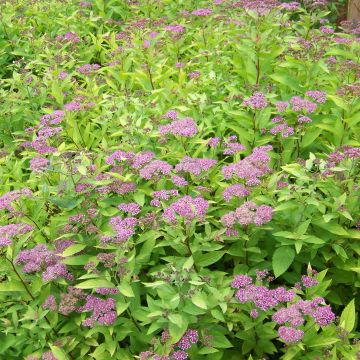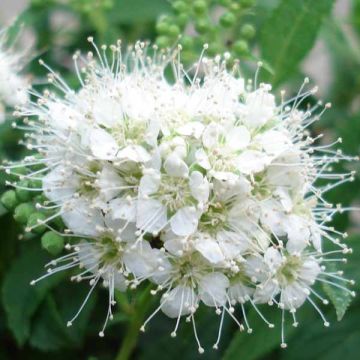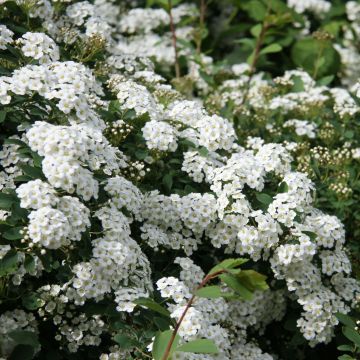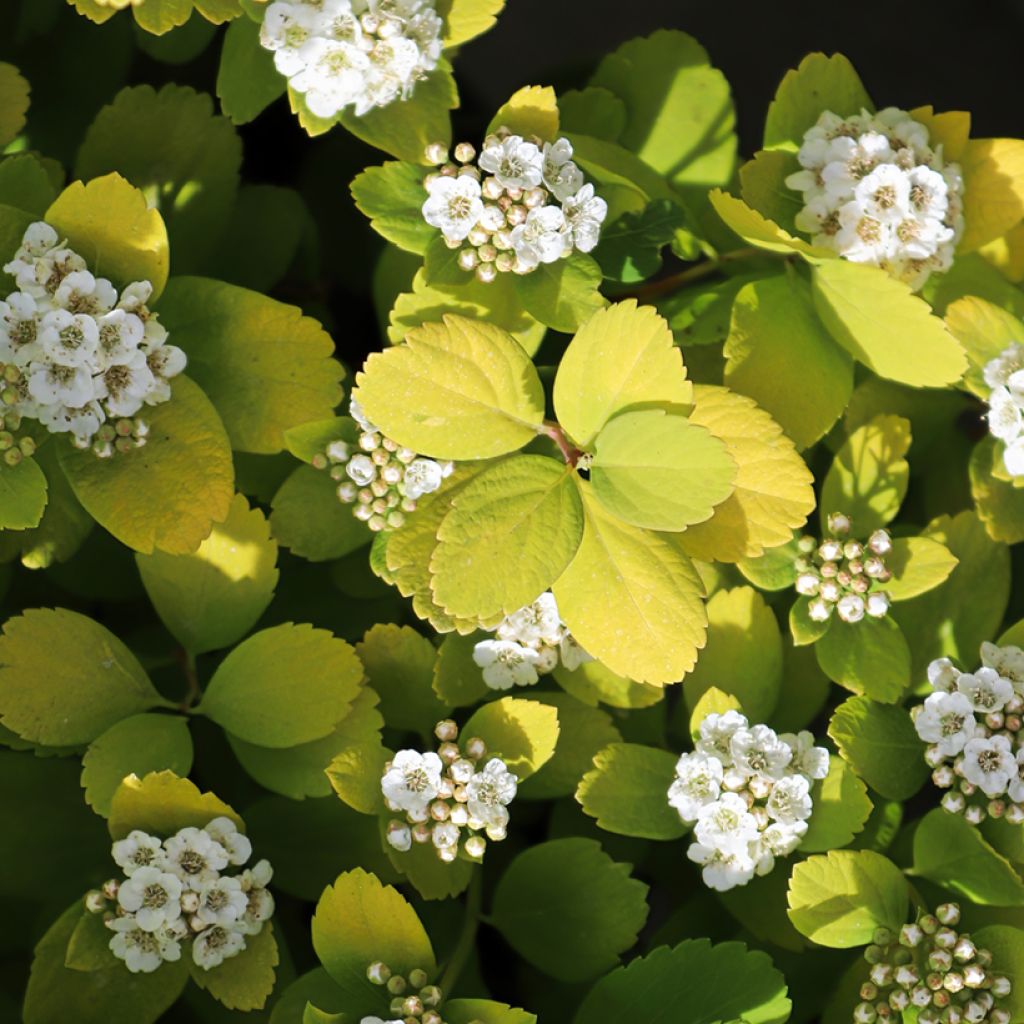

Spiraea betulifolia Island
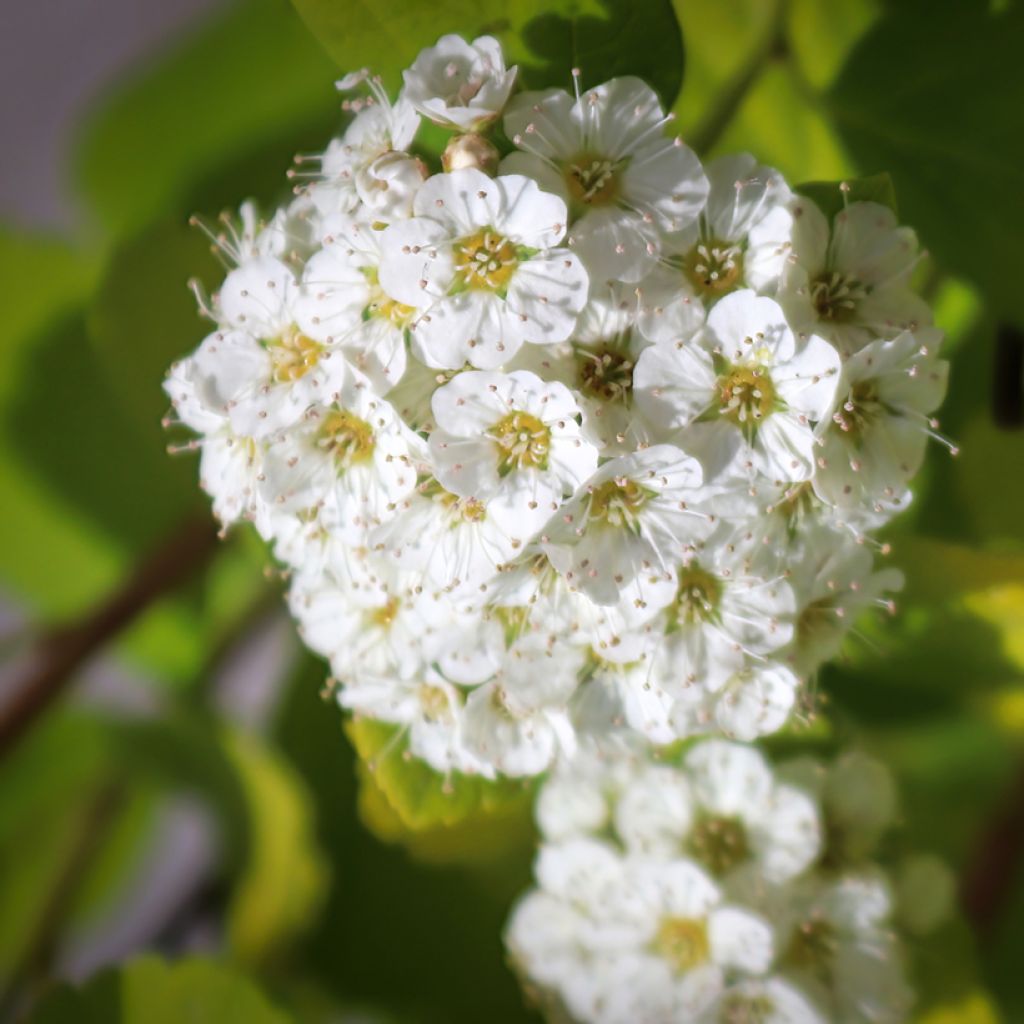

Spiraea betulifolia Island
Spiraea betulifolia Island
Spiraea betulifolia Island
Spirée à feuilles de bouleau
This item cannot be shipped to the selected country
Delivery charge from €5.90
Delivery charge from €5.90
Delivery charge from €5.90
More information
Schedule delivery date,
and select date in basket
This plant carries a 24 months recovery warranty
More information
We guarantee the quality of our plants for a full growing cycle, and will replace at our expense any plant that fails to recover under normal climatic and planting conditions.
From €5.90 for pickup delivery and €6.90 for home delivery
Express home delivery from €8.90.
From €5.90 for pickup delivery and €6.90 for home delivery
Express home delivery from €8.90.
From €5.90 for pickup delivery and €6.90 for home delivery
Express home delivery from €8.90.
Does this plant fit my garden?
Set up your Plantfit profile →
Description
The Spiraea betulifolia 'Island', or Birch-leaved Spirea, is a small bush or shrub with a compact habit and massive spring flowering in clusters of small white flowers that butterflies love. In autumn, its foliage turns beautifully yellow and orange. Accommodating and easy to grow, it will find its place in many gardens and adapt to most climates. Its limited growth makes it a good container plant to enhance a terrace or a border along a pathway.
The Birch-leaved Spirea 'Island' belongs to the large family of Rosaceae, which includes most of our fruit species (Apple trees, Pear trees, Cherry trees, Apricot trees), many wild plants, and a multitude of ornamental plants. Besides Roses, of course, it includes the genera Cotoneaster, Amelanchier, Pyracantha, Kerria, Photinia, etc. The Spiraea genus alone has around a hundred species, including the S. Betulifolia native to Eastern Siberia, Japan, and Sakhalin Island. It derives from its geographical origins an excellent cold resistance (around -30 °C) and forms a small shrub with an almost spherical habit.
The growth of this Island variety is slow and its mature size will not exceed 80 cm (31.5 in) in height by 60 cm (23.6 in) in width. The flowering, which takes place in May-June, is so abundant that the shrub disappears under a white blanket of snow. The very small flowers are grouped in clusters measuring 7 to 8 cm (2.8 to 3.1 in) and are highly appreciated by butterflies. The oval, toothed leaves are medium green and resemble those of birch trees. This small shrub ignites in autumn, with its foliage taking on shades of yellow to orange, or even purple, depending on the nature of the soil.
Plant this spirea in well-drained soil, not too dry. This shrub will thrive in partial shade, but preferably in full sun. The autumn colours will be richer and more pronounced in neutral to acidic soil.
The Spiraea betulifolia 'Island' is a perfect candidate for decorative container planting. In the ground, this shrub will perfectly complement low-growing perennials in a mixed bed. The association with a carpet of Nepeta mussinii will guarantee a very wide flowering range, from spring to autumn, for a highly durable decorative effect. In the same spirit, Hemerocallis with their magnificent flowers blooming throughout much of the summer (if different varieties are planted from the wide range available) will be perfect companions. Among shrubs, a beautiful Purple-leaved Weigela will provide a remarkable contrast throughout the season, as well as a Golden Carpet Barberry with yellow-green leaves planted in the foreground of this Spirea.
Report an error about the product description
Spiraea betulifolia Island in pictures
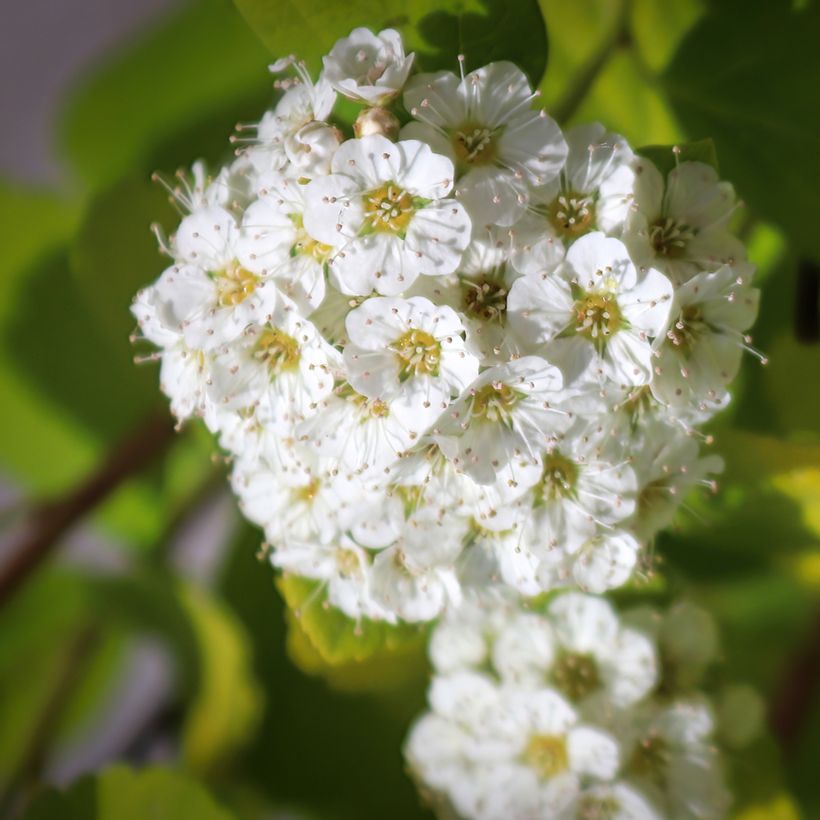

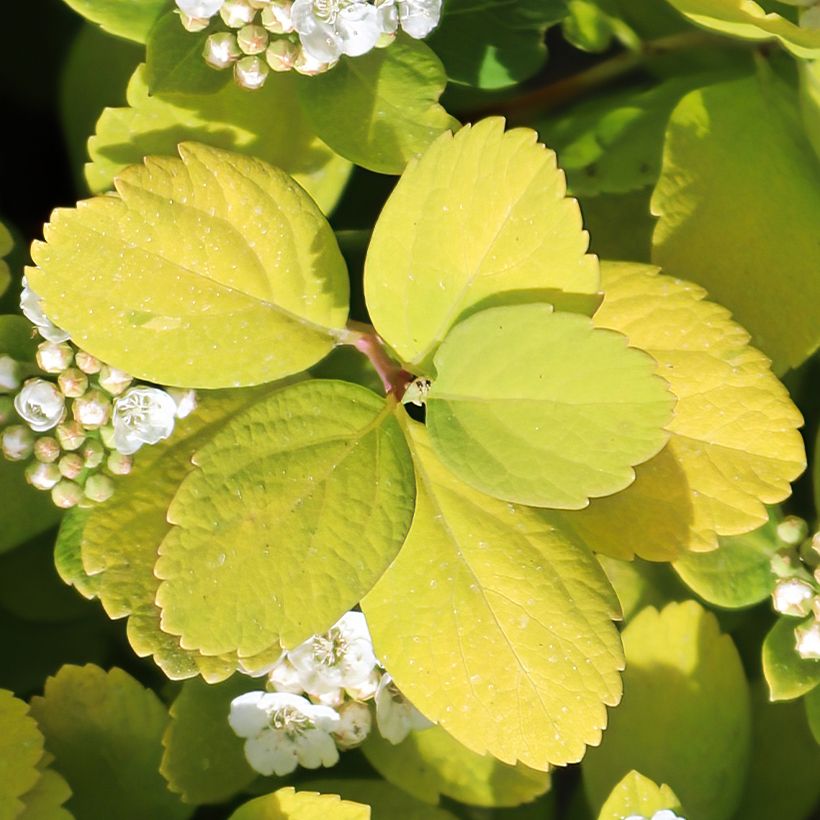

Plant habit
Flowering
Foliage
Botanical data
Spiraea
betulifolia
Island
Rosaceae
Spirée à feuilles de bouleau
Cultivar or hybrid
Other Spiraea
Planting and care
Choose a sunny location or possibly partially shaded and dig a planting hole 50 to 60 cm (19.7 to 23.6 in) on each side and bottom. This Bush is not very demanding in terms of soil as long as it remains slightly moist and properly drained. Neutral soils are perfect, but it can adapt to moderately acidic or alkaline (limestone) soils. If your soil is poor or sandy, add a compost-enriched soil mix at planting and mix it equally with the existing soil. Soak the root ball of the bush in a bucket of water for fifteen minutes, place it in the planting hole, backfill and water generously. Water regularly for the first two years, especially during dry summer periods.
Once established, this Bush will prove to be sturdy and resistant to diseases. In case of aphid attack in spring, spray diluted black soap at the recommended dosage on the can. Or wait until ladybugs have done their job.
Planting period
Intended location
Care
This item has not been reviewed yet - be the first to leave a review about it.
Haven't found what you were looking for?
Hardiness is the lowest winter temperature a plant can endure without suffering serious damage or even dying. However, hardiness is affected by location (a sheltered area, such as a patio), protection (winter cover) and soil type (hardiness is improved by well-drained soil).

Photo Sharing Terms & Conditions
In order to encourage gardeners to interact and share their experiences, Promesse de fleurs offers various media enabling content to be uploaded onto its Site - in particular via the ‘Photo sharing’ module.
The User agrees to refrain from:
- Posting any content that is illegal, prejudicial, insulting, racist, inciteful to hatred, revisionist, contrary to public decency, that infringes on privacy or on the privacy rights of third parties, in particular the publicity rights of persons and goods, intellectual property rights, or the right to privacy.
- Submitting content on behalf of a third party;
- Impersonate the identity of a third party and/or publish any personal information about a third party;
In general, the User undertakes to refrain from any unethical behaviour.
All Content (in particular text, comments, files, images, photos, videos, creative works, etc.), which may be subject to property or intellectual property rights, image or other private rights, shall remain the property of the User, subject to the limited rights granted by the terms of the licence granted by Promesse de fleurs as stated below. Users are at liberty to publish or not to publish such Content on the Site, notably via the ‘Photo Sharing’ facility, and accept that this Content shall be made public and freely accessible, notably on the Internet.
Users further acknowledge, undertake to have ,and guarantee that they hold all necessary rights and permissions to publish such material on the Site, in particular with regard to the legislation in force pertaining to any privacy, property, intellectual property, image, or contractual rights, or rights of any other nature. By publishing such Content on the Site, Users acknowledge accepting full liability as publishers of the Content within the meaning of the law, and grant Promesse de fleurs, free of charge, an inclusive, worldwide licence for the said Content for the entire duration of its publication, including all reproduction, representation, up/downloading, displaying, performing, transmission, and storage rights.
Users also grant permission for their name to be linked to the Content and accept that this link may not always be made available.
By engaging in posting material, Users consent to their Content becoming automatically accessible on the Internet, in particular on other sites and/or blogs and/or web pages of the Promesse de fleurs site, including in particular social pages and the Promesse de fleurs catalogue.
Users may secure the removal of entrusted content free of charge by issuing a simple request via our contact form.
The flowering period indicated on our website applies to countries and regions located in USDA zone 8 (France, the United Kingdom, Ireland, the Netherlands, etc.)
It will vary according to where you live:
- In zones 9 to 10 (Italy, Spain, Greece, etc.), flowering will occur about 2 to 4 weeks earlier.
- In zones 6 to 7 (Germany, Poland, Slovenia, and lower mountainous regions), flowering will be delayed by 2 to 3 weeks.
- In zone 5 (Central Europe, Scandinavia), blooming will be delayed by 3 to 5 weeks.
In temperate climates, pruning of spring-flowering shrubs (forsythia, spireas, etc.) should be done just after flowering.
Pruning of summer-flowering shrubs (Indian Lilac, Perovskia, etc.) can be done in winter or spring.
In cold regions as well as with frost-sensitive plants, avoid pruning too early when severe frosts may still occur.
The planting period indicated on our website applies to countries and regions located in USDA zone 8 (France, United Kingdom, Ireland, Netherlands).
It will vary according to where you live:
- In Mediterranean zones (Marseille, Madrid, Milan, etc.), autumn and winter are the best planting periods.
- In continental zones (Strasbourg, Munich, Vienna, etc.), delay planting by 2 to 3 weeks in spring and bring it forward by 2 to 4 weeks in autumn.
- In mountainous regions (the Alps, Pyrenees, Carpathians, etc.), it is best to plant in late spring (May-June) or late summer (August-September).
The harvesting period indicated on our website applies to countries and regions in USDA zone 8 (France, England, Ireland, the Netherlands).
In colder areas (Scandinavia, Poland, Austria...) fruit and vegetable harvests are likely to be delayed by 3-4 weeks.
In warmer areas (Italy, Spain, Greece, etc.), harvesting will probably take place earlier, depending on weather conditions.
The sowing periods indicated on our website apply to countries and regions within USDA Zone 8 (France, UK, Ireland, Netherlands).
In colder areas (Scandinavia, Poland, Austria...), delay any outdoor sowing by 3-4 weeks, or sow under glass.
In warmer climes (Italy, Spain, Greece, etc.), bring outdoor sowing forward by a few weeks.

































